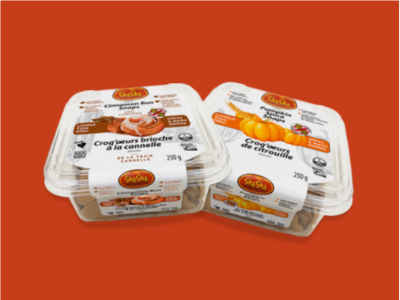A question of ‘progress’
Written by: Shasha Navazesh
Why is obesity such an overwhelming problem in our society? Why are cancer, diabetes, allergies and other illnesses on the rise? Why is such a high percentage of the North American population hypoglycemic? The answer is simple: the foods we eat aren’t meeting our needs. In fact, much of what we eat is actually damaging us.
So, why aren’t we eating well? Over the past 200 years, food has changed dramatically. Humans have changed too. But they don’t seem to have changed together.
In the past 100 years, the human genome has been mapped, the atom has been split, our use of technology has exploded, and our understanding of the world has grown exponentially. We have gained a new capacity for multitasking and dealing with stress and crisis. We’re using more of our brains and our life expectancy has almost doubled. We have changed almost everything about the way we live and work.
The quality of food we eat has changed, too, but not in a good way. The evolution of food is not keeping up with the evolution of the people who eat it.
Five thousand years ago, humans first cultivated seeds. Two thousand years ago, the Egyptians invented fermented bread. For millennia, people made their own bread from whole-grain, locally milled wheat. Then, 200 years ago, the industrial revolution happened, and milling stopped being a small-batch, local pursuit, and became a manufacturing process in which factory mills were faster and could produce more flour.
Since then, bread – and food in general – has taken a huge leap toward mass production. Because foods started being made in such vast quantities, they could not be consumed as soon as they were made. They required storage, and needed to have a longer shelf life. So in came the additives and preservatives. And out went nutrition and freshness.
Since the industrial revolution, everything has become about making more stuff faster. In the food industry, quantity trumps quality. Seeds are genetically modified to grow faster and produce heartier crops that can be stored and shipped without damage. Nitrogen is used as fertilizer, resulting in huge yields; herbicides, pesticides and chemical fertilizers add to the toxic, carcinogenic cocktail. Vast tracts of land are used for single crops, depleting the soil of key nutrients and minerals. For example, silica, a nutrient that keeps skin resilient, no longer exists in the land. Now taking a pill is our only option.
Food isn’t about nutrition anymore. It’s about big business.
Let’s take bread as an example. Once milling was industrialized, a bleaching agent was introduced into the process to create white flour, which was perceived to be cleaner and more “upscale” than its rougher-looking (yet infinitely healthier) unbleached counterpart. Bleaching flour involves taking out the bran and the germ – which contain pretty much all of the nutrients – and leaving behind only starch.
Today, we’ve concluded that bleached white flour isn’t good for us. So the government, instead of encouraging traditional milling, has mandated white flour be enriched. That means all the bran and germ is stripped out of the wheat, then pharmaceutically made nutrients (which are, as you might imagine, more difficult for bodies to absorb, since they’re artificial) are added back in. Why aren’t the nutrients left in to begin with? Because doing it the old-fashioned way is expensive and time-consuming, and most people aren’t willing to spend the extra money on their food.
This departure from food as sustenance to food as a product isn’t limited to bread. It’s everywhere, in everything we eat. Remember when tomatoes tasted good? Your tastes haven’t changed. The tomatoes have. Seriously, if you ever ate a tomato in Italy, or one grown in your backyard from an heirloom plant, you would never touch the flavourless ones in the produce department again. Food has evolved from local, small-batch, homemade sustenance to a manufactured, mass-produced product. That adds up to a basic lack of nutrients – and toxins our bodies don’t know what to do with. Manufactured foods cheat our bodies. So we get fat. We get sick. We are literally killing ourselves with bad food. It’s sad and disturbing. Fruits and vegetables no longer smell or taste like they’re supposed to. In an effort to bring us fruit that looks beautiful and can be transported great distances, producers have robbed their products of flavour, aroma and nutrients. Everything is about shelf life and durability. Items have to be picked unripened so they’ll last longer. But ripe fruits and vegetables have the highest enzyme activity and highest level of nutrients. Most of the things we buy are picked at 50 per cent or less of that potential. And so many of the foods we eat are genetically modified – again, for durability, shelf life and resistance to pests. You know those Granny Smith apples that have extra-thick skin? They’re like that because they have been combined with fish genes.
That’s what we’re eating. It’s what we’re feeding our children. And yet we wonder why, even when we “eat right,” it isn’t making us as healthy as it should. Cancers and allergies are a byproduct of the things we are doing to our food sources and our environment. People have started waking up to this fact. It’s a movement that started in the 1960s, but really took off in the ’90s, when people sat up and said, “What the hell are we doing to ourselves?”
We’re realizing that being able to eat strawberries in January means leaving a huge carbon footprint. That maybe eating things sprayed with chemicals designed to kill weeds and insects probably isn’t so good for our bodies, either. That stripping the natural nutrients out of food and then adding artificial ones back in doesn’t make sense. So many of us are eating more healthfully and making better choices. But when the choices we have are poor, what should we do?
Ideally, we should make food the way it was done 200 years ago. However, I know that eating organically and locally is something that can’t work on a global level; it’s too expensive and time-consuming. You can’t feed six billion people with organically grown products. Without genetic modifications, etc., we would simply not be able to feed the world. So I can’t, in all fairness, condemn the entire system.
It’s necessary. But it’s certainly not ideal. We need something bigger and better that can feed everyone – properly.
So what do we do? I think food has to go backward to match the forward movement of human evolution. We need to find a new way of growing, storing, processing, manufacturing and consuming food. We may not be 100 per cent sure of what that should be, but here are a few things we do know:
- Growing food should not be damaging the soil. Farmers should be rotating crops, and the government should be encouraging responsible farming.
- We shouldn’t be shipping food across continents. Growing and storage should be done at a local level as much as possible, with minimal logistics and movement. We should eat locally and seasonally.
- We should be phasing out herbicides, pesticides, additives and preservatives, and finding natural ways of protecting crops and keeping products fresh.
- We should be rethinking genetic modification of our foods. The best way to do that is to be educated – and stop buying questionable foods that have been designed in a lab. In Europe, for example, where genetically modified foods are not permitted, the incidence of people with wheat allergies is significantly lower than in North America.
- We need to change the way we think about food. We shouldn’t be eating three large meals a day, and getting hungry in between. When we get hungry, we run out of energy. We get moody, tired and irritable. So we reach for a fast source of energy – our bodies crave sugar. But as we know, sugar enters the bloodstream quickly, giving us a boost; after it spikes, we crash. So we reach for more sugar. This is the nasty cycle that causes obesity. Instead, we need a continued source of energy that provides constant nutrients. If we had a source that kept us satiated, we would make fewer bad food choices – and have healthier lives.
There’s no single answer to this issue. But it helps to spread awareness. At Shasha Co., we try to educate people. We’re also trying to do our part by creating a range of tasty, functional, raw, low-glycemic-index foods that are grown naturally, contain actual nutrients, undergo minimal processing, can be consumed throughout the day, and don’t leave a big carbon footprint. They are multi-use foods that can be used as snacks, cereals, or porridges, can be cooked with other ingredients, or just eaten as snacks. Our bodies need these types of foods, and our planet needs us to produce them in a responsible way.
To make a real difference in our health and our environment, we need to change the way we look at food and eating. And that will take time and effort. But I hope this article is a step in that direction, something that makes us think about what we eat and the products we produce and sell. / BJ
Shasha Navazesh is the owner of Shasha Co., a natural artisan bakery in Toronto. He is also the founder, chairman and president of the Artisan Bakers Quality Alliance.












